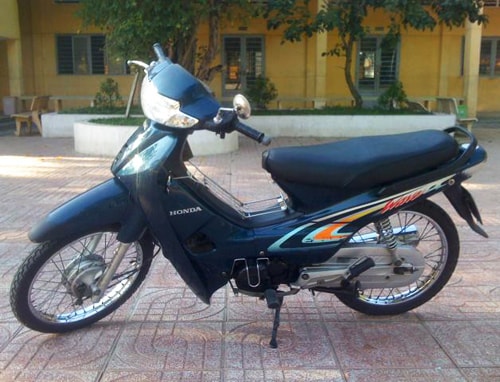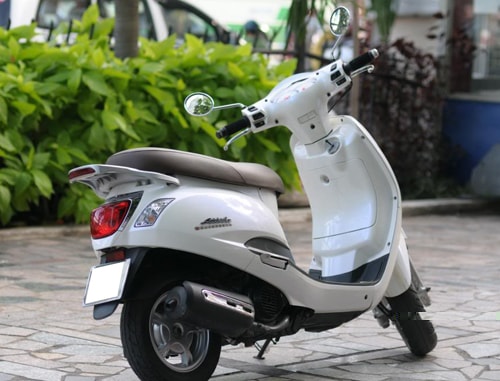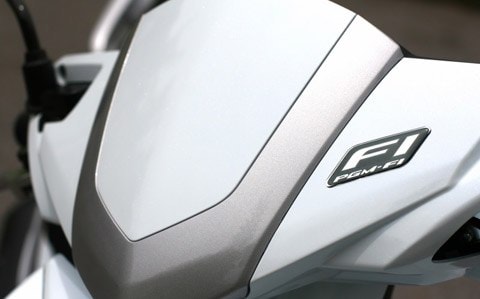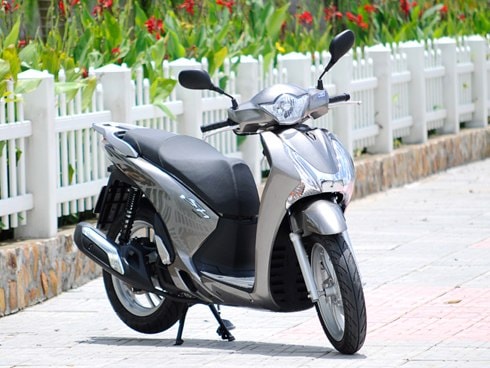Important moments of the Vietnamese motorbike market
The invasion of Chinese vehicles, the birth of mid-range scooters and electronic fuel injection technology are significant milestones that have greatly influenced the Vietnamese motorbike market.
The Vietnamese motorbike market only really took shape when major car manufacturers invested in building motorbike assembly plants in Vietnam around the late 90s. Although it was not within the 15-year period of formation and development of the Vietnamese motorbike market, the appearance of imported models was the source of demand for motorbikes in the S-shaped strip of land.
1. Imported car lines
 |
Honda Dream II. Photo: Duc Quang.
If Honda 67 and Vespa PX appeared a long time ago, names like Dream II, Cub, and Suzuki Viva appeared later and were known and used more by people.
Honda Dream II appeared around 1992 in Thailand. At that time, motorbikes were really a valuable asset and worth more than houses. Even when motorbikes were popular, the mark of the time could still help the "genuine" Dream II to be sold for 100 million VND.
In the list of original models, there is the name Suzuki Viva. It comes after Dream but is equally outstanding. The car is solid, sturdy, durable, owning Viva is like owning a luxury car today. Besides that, we cannot forget the "highway heroes" of Suzuki manual clutch such as RGV, FX 125, Raider, names that made young people lose sleep at one time.
The most recent and expensive trend is imported high-end scooters, such as SH, Dylan, @ or Spacy, which only appear in the city, affirming the owner's class. Also because of this imported vehicle class, scooters at that time were defined as expensive vehicles, difficult for ordinary people to own, until Yamaha Nouvo appeared to rebuild the market.
2. Chinese cars and the cheap motorbike war
 |
Honda Wave Alpha successfully competes with Chinese vehicles.
Chinese cars are associated with low prices and poor quality. But on the other hand, this number of cars has contributed greatly to forcing Japanese car manufacturers to change their strategies, making it easier for people to own motorbikes.
In 1999, when Honda and Yamaha entered Vietnam, the price of motorbikes was around 20-30 million VND and had no intention of decreasing. A year later, Chinese motorbikes suddenly flooded in with models identical to Japanese motorbikes but the price was only half, around 10 million VND. The thirst of a developing market was immediately satisfied, helping motorbikes grow by an unimaginable 300% in 2000.
Japanese companies are falling from being giants with more than 90% market share to 30%. "The situation was as hot as an armed war, we had to find a way to regain market share", a former manager of Honda Vietnam recalled. Honda Japan put itself on red alert when it had to find a way to save its joint venture in Vietnam. As a result, Wave Alpha appeared in February 2002 with cheap components supported by Honda factories in China.
With a price of 11 million, slightly higher than Chinese cars, but the brand power and quality make Wave Alpha quickly help Honda regain market share. Chinese cars destroy each other and gradually lose their shine.
Along with Honda, Yamaha, Suzuki and SYM have also gradually regained their dominance. Currently, Honda and Yamaha account for 90% of the market share, while Chinese vehicles are almost absent, ending one of the most spectacular market battles in Vietnam.
3. Scooter boom
 |
SYM Attila is a model that marks the popular scooter market.
If Chinese cars brought the manual transmission market to the 10 million price level, SYM Attila was the name that helped scooters become popular. Born around 1998, Attila was considered to be a copy of the famous imported Honda Spacy, but the cheap price helped many people approach the concept of "scooter".
Before Attila appeared, the scooter market was very small, mainly imported models such as Honda Spacy, SH, @... with a market share of only about 2-3%. Although Attila defined a new perspective on scooters, the Taiwanese model was more feminine, still lacking a large market for male customers. Yamaha Nouvo, born in 2002, was the answer.
The revolution and Nouvo created represent a fashionable, sporty, easy-to-operate, convenient and affordable mid-range motorbike. According to experts, since then, the Vietnamese scooter market has been divided into four distinct stages.
The first phase was the start-up (2002-2003), at this time the scooter market share was about 9% with Nouvo 7% and Attila 2%. The second phase was market penetration (2004-2007), with more products from Japanese brands such as Nouvo, Mio of Yamaha, Click of Honda and of course Attila of SYM still having a place. At this stage, the scooter market share increased, reaching about 18% of the domestic motorcycle market.
The rapid growth period (2008-2010) was formed after Honda launched Air Blade in April 2007. During this period, the Italian scooter company Piaggio also entered the Vietnamese market with the legendary Vespa line. Thus, along with Vespa, the names Air Blade, Lead, Nouvo continued to lead sales, bringing the scooter market share to 35%. The final period is stability (2011-present), with scooters accounting for about 40% of the market.
4. Electronic fuel injection
 |
FI becomes the criteria for consumers to evaluate motorbikes.
Electronic fuel injection FI is the hottest technology related factor when it becomes a race of most car manufacturers. The first product to apply FI (Fuel Injection) is the Honda Future Neo FI in 2007.
With the advantage of using electronic sensors to calculate the amount of fuel entering the combustion chamber most accurately for optimal fuel consumption, besides there is no phenomenon of difficulty starting in cold weather, FI is welcomed by consumers.
After Future Neo FI, Honda itself as well as its competitors continuously launched FI versions with prices a few million VND higher than normal. If FI was first introduced for the top models, now this technology is used for both scooters and popular manual transmission vehicles.
Honda currently has about 15 versions of all models sold on the market, of which 9 versions use electronic fuel injection. Yamaha is not far behind when it recently introduced FI into Sirius 2013, a popular manual transmission model, Yamaha's original model in the Vietnamese market.
Because of this development, FI is gradually becoming the criteria that consumers use to compare when considering between vehicle models. Therefore, a small number of products that are not equipped with electronic fuel injection will gradually integrate into the general trend in the near future.
5. Localization of high-end scooters
 |
SH has a seat height of 799 mm.
When Nouvo was born, it created a market segment for popular and mid-range scooters. But imported high-end scooters are still a fertile land because of the Vietnamese consumer's preference for appearance and "imported vehicles". One by one, the names Honda SH, Vespa, Lambretta were localized with a "deep" ratio, causing the price to decrease a lot, high-end scooters are no longer luxury models.
Localization of high-end scooters also makes scooters increasingly popular. For example, with Honda SH, right after reaching a 93% localization rate with a new global design that did not suit Vietnamese consumers, the company continued to launch SH Mode for 50 million. The SH brand is no longer as high as it was when it was imported. Currently, Honda and Vespa are sharing the exploitation of this land at a ratio of about 60/40.
When the scooter segments were brought together by the companies, there were many choices but no differences. Besides, manual transmission vehicles did not have any outstanding features, causing consumers, especially the young, to gradually move away and switch to manual transmission vehicles, the segment that Yamaha and Suzuki focused on developing.
According to vnexpress






